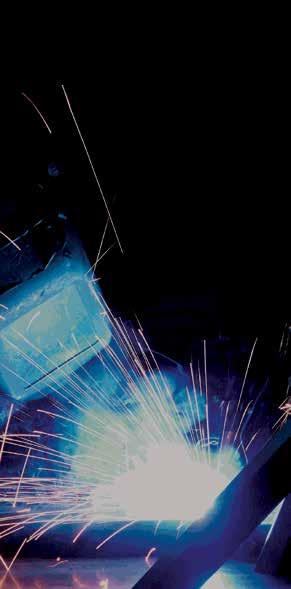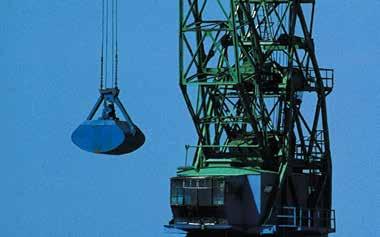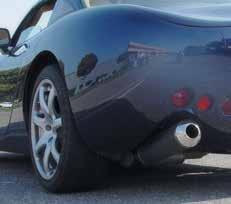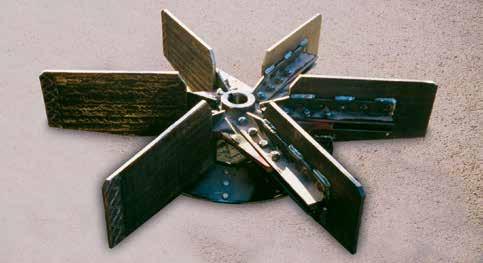
7 minute read
Select-Arc Hardsurfacing Products
HARDSURFACING


Select-Arc Hardsurfacing Products
Hardsurfacing encompasses a broad range of alloy compositions which are designed for a variety of applications. The basic concept is to deposit, by an arc welding process, an alloy onto a metallic component which resists wear more effectively than the base metal of the component. By doing so, you increase the component life. The hardsurfacing alloy may also be required to provide additional resistance to other conditions including impact, adhesion, corrosion, erosion or elevated temperatures.
Reasons for Hardsurfacing Metal components eventually wear out from use or break in service. Until the advent of buildup and hardsurface welding operations, the part was discarded and replaced with a new O.E.M. part. Initially, the idea was to reclaim the worn part by building up the worn area with welding and/or subsequent machining. This practice of reclaiming the worn component proved to be a significant cost savings over the purchase of a new component. Some time later, the concept of improving the life of a metal component by welding a more wear resistant alloy to the components surface evolved. Again, this proved to be a great value in reducing the cost of operation.
Hardsurfacing does the following:
1. Reduces the cost of operation by reclaiming worn components at a fraction of the new O.E.M price. 2. Increases the life of components by utilizing more wear-resistant alloys. 3. Reduces machinery downtime by increasing component life. In conclusion, reclamation by the use of buildup and hardsurface welding reduces costs of operation, making you more competitive in your industry. Alloy, Hardness vs. Wear One common misconception is that higher hardness in the weld deposit yields better wearresistance. Greater hardness does not always equate to less wear and longer component life. Different alloys with similar hardness values can result in entirely differing wear-resistance properties. Typically, the volume density, or amount of carbide present in the alloy matrix, imparts the wear-resistant properties to the alloy deposit. Therefore, the greater the volume of carbide, the greater the wear- resistance of the alloy. In some cases, the most wear-resistant alloy is not always the best solution for the application. As carbide volume increases, the more crack sensitive and less impact resistant the deposit becomes. The choice of which hardsurfacing alloy to use is normally a compromise between wearresistance and impact-resistance of the alloy for a given application.
Surfacing Alloy Groups Hardsurfacing and buildup alloys are generally broken down into broad groups. Some groups can be broken down into smaller, more specific groups, but this is unnecessary for the majority of the market.
Buildup Alloys The buildup group is composed of lower carbon, low alloy steels, similar in range of chemistry to the component being reclaimed. By arc welding, the component is rebuilt to near original dimensions prior to final hardsurfacing operations. Typically, these alloys are machinable and offer a good combination of hardness and toughness.
Consideration should be given to heat treating procedures when welding with these alloys to reduce residual stresses caused by the welding process, reducing the potential for cracking.
Austenitic Alloys Typically, austenitic steels exhibit very good toughness and strength under high impact conditions. As deposited, these alloys can be very ductile, yielding hardnesses in the range of 17 to 23 Rockwell C scale hardness (HRc). Under impact, the alloy microstructure deforms, or work hardens, resulting in a hard, tough surface layer. Hardness can be increased to a range of 44 to 54 HRc. Because of the initial ductility of the deposit, buildup depth is generally unlimited. Some of the austenitic group can be considered both buildup and hard-surfacing alloys due to their ability to be deposited as a very ductile alloy and then work harden in service. This work hardening property makes them an ideal choice for rebuilding manganese crusher parts where extreme impact with low abrasion is encountered.
Martensitic Alloys The martensitic group includes a wide variety of hardsurfacing and some buildup alloys. These alloys are generally considered a good choice for metal-to-metal wear-resistance. Weld deposits yield good impact and abrasion properties. These alloys are also termed “air hardenable” meaning that the cooling rate is directly related to final hardness. Faster cooling promotes formation of the martensitic structure. Care must be taken with regard to heat treatment procedures (preheat, interpass, postweld stress relief) to avoid residual stresses and cracking of the weld deposit.
Carbide Containing Alloys This group of alloys can include many different carbide forming elements either alone or in combination. Typically high in carbon content, the weld deposit is composed of single, primary
type carbides or multiple carbides (complex carbides) in an iron matrix. The design of these alloys is such to allow the matrix material to hold the carbides in place under impact/ abrasion conditions. The carbide structures impart the wear-resistant properties to the deposit, but require the matrix material to be tough enough to endure the impact. High density carbide alloys are considered the best choice for high abrasion wear conditions with some impact. Carbide forming elements include boron, chromium, columbium (niobium), molybdenum, titanium, tungsten and vanadium. The deposits tend to stress relief, crack check and are limited in depth of deposit depending on specific application.
Non-Ferrous Alloys
When discussing non-ferrous alloys used in the hardsurfacing industry, we are mainly referring to the cobalt and nickel based alloys. These alloys contribute additional properties including corrosion resistance, oxidation resistance, high temperature hardness, strength and creep resistance. Due to their higher cost over other iron based alloys, their use is limited to very specific applications where the additional material cost is justified. Select-Arc has designed a line of hardsurfacing products which offer the highest level of metallurgical and welding performance. These cored wires are formulated to produce consistency of deposit composition and welding characteristics. From incoming inspection of alloy and mineral powders to the mixing operation to the fabrication of the wire, measures are in place to ensure that every pound of product meets specified performance criteria.
Rigorous checks of all raw materials are ongoing to verify that they conform to purchasing requirements. Dimensional requirements of steel are continuously monitored for accuracy and conformance. Fill percentages are checked every 600 pounds to ensure consistency throughout each mix of product. Chemical analysis is performed on finished wire produced from each dry mix of every electrode. This translates into a deposit chemistry for every 1000-2000 lb. of manufactured wire. Weldability evaluations are conducted for wire samples representative of each dry mix; these evaluations are used to assess the arc characteristics, spatter levels, feedability, deposit appearance and overall welding performance of the electrode. These

actions are the result of a quality system which is designed to manufacture a cored welding electrode to meet customers’ expectations; it is not to be confused with a quality manual containing slogans and platitudes which add nothing to the production of quality material.
Complimenting Select-Arc’s premier quality reputation are three other factors which make us the right source for hardsurfacing tubular wires; modern and proprietary manufacturing equipment, superb customer and technical service, and a responsive and talented product development group. Wire manufactured on Select-Arc’s state-of-the-art equipment is technologically superior to wire which has traditionally been fabricated and rolled to size with hydraulic rolling mills. Wire produced on our fabricating and drawing machinery is free of seam irregularities, slivers, fins and other surface imperfections associated with rolling mills. Our mixing and feeding technology ensures the highest consistency throughout the blended mix, powder feeders and dispersion within the core of the wire. This uniform dispersion of core ingredients eliminates worries of alloy segregation which, in turn, maximizes the consistency of deposit composition, weld metal hardnesses, and resistance to abrasion, wear, corrosion or impact. Select-Arc’s equipment can manufacture wire diameters from 5/32” down to 0.035” (for certain alloys). Each diameter is processed to provide smooth feeding characteristics and superb welder appeal.
Customer and technical services are essential to satisfying customer expectations, by means of proper internal and external communications. Information must be transferred accurately and promptly, and responses must be timely. Select-Arc prides itself on providing excellent customer service, accurate technical service and professional technical support. Select-Arc also has a staff of application specialists for assisting customers with welding and application problems. Their mission is to
provide solutions to problems and assistance in applying the proper product to specific welding situations. These specialists are available for training customers in the proper use of our products and the selection of the best welding electrode for each application.
It is not possible to develop, implement and expand a line of tubular hardsurfacing electrodes without a good product development team, and Select-Arc has one of the best in the industry. Our staff of engineers and technicians can react swiftly to customers’ requests, whether they are development of new products or modifications to existing ones. Select-Arc’s development engineers, all with metallurgical backgrounds, have the unique ability to formulate both the slag systems and alloy compositions that can be tailored to each customer’s requirements.





